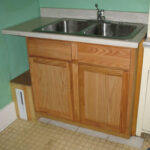Installing a kitchen countertop can be a real adventure in frustration if you do not have any experience. Kitchens tend to have a several potential pitfalls for the amateur when doing a countertop installation. You may be facing the situation where the countertop has to fit from one wall to the next for a single run of cabinets. It is possible that you have to navigate around a corner that may or may not be square. If the countertop has a backsplash, it is important that it fits snugly against the wall. The list can go on and on. The good news is that most kitchen countertop installations are not terrible. With a few tips, there is no reason that the process should be anything but successful.
Be very careful when measuring the kitchen for the counter top.
Although the countertop does not have to fit exactly perfect, it should get pretty close. The key is to take good measurements. When taking the measurements, err on the side of being 1/2 inch short instead of 1/2 inch long. This may sound counterintuitive, but it is the right way to go. Countertops are not that easy for the amateur to cut off. However, being 1/2 inch short is just 1/4 inch on each end. This amount of space can be filled with silicon or caulk and will still look nice. It is best to get as close as possible so that minimal filling is needed.
Try to determine if the room is square.
Use a carpenter’s square any corner where the countertop will be to see if the room is square. If you are having a custom countertop made, the craftsman will want to know what types of adjustments to make to the countertop so that it will fit. You may want to spend the money, if necessary, to have the builders come to your house and do this part for you. It is possible to fill in the spots that are not square. Like the length, it is better if the countertop just fits correctly.
Find out how the countertop is to be attached to the cabinets.
If you have removed an old countertop from these cabinets, the new countertop will attach in the same way that the old one did. However, if you are installing new cabinets, you need to know how they are designed for the countertop to be attached. There are two primary ways that this is done. Some cabinets have boards attached inside their top rails with holes drilled for you to insert screws that will go into the underside of the countertop. Other cabinets require brackets to be installed at the top inside of the cabinets to serve this purpose. Other methods exist, but these two are used often.
You may need to cut out a spot for the sink.
Most new sinks come with a template enclosed to assist in the task of making the cutout for the sink to be inserted into the countertop. Cut out the paper template with scissors and tape it securely to the countertop. Using a sabre saw, cut out the opening for the sink. This can be done before or after the countertop is set in place, but it is usually easier to do if the countertop is already in place.
Get enough help to be able to lift the countertop without breaking it to put it on top of the cabinets.
It is time to install the countertop. Raise it above the level of the cabinets and carefully ease it into position. It may require a little effort, but keep working with it until it fits as precisely as possible. Once you are sure that it is properly positioned, attach it to the cabinets. Be extremely careful not to damage the surface by sinking screws too deeply into the underside.
Use silicon or caulk to fill any gaps that may remain and to seal the back of the countertop to the wall.
It is important to do a good and neat job of sealing up any remaining openings between the back of the countertop and the wall. This not only makes the project more pleasing to the eyes, it also makes a barrier to prevent water from getting behind your cabinets.
Install the sink into the countertop.
It is easiest to install the faucets into the sink before dropping it into place. Attach the riser tubes at this time also. This way when the sink is in place, you only have to make the lower connections. For under-the-counter mounts, just follow the instructions that are specific to your sink. Other sinks require a ring that holds the sink into place. If you are using a raised sink, it will usually rest on top of the countertop. It is best to put some plumber’s putty under this type of sink to make a seal. It may also require some silicon around the edge to complete the job.



